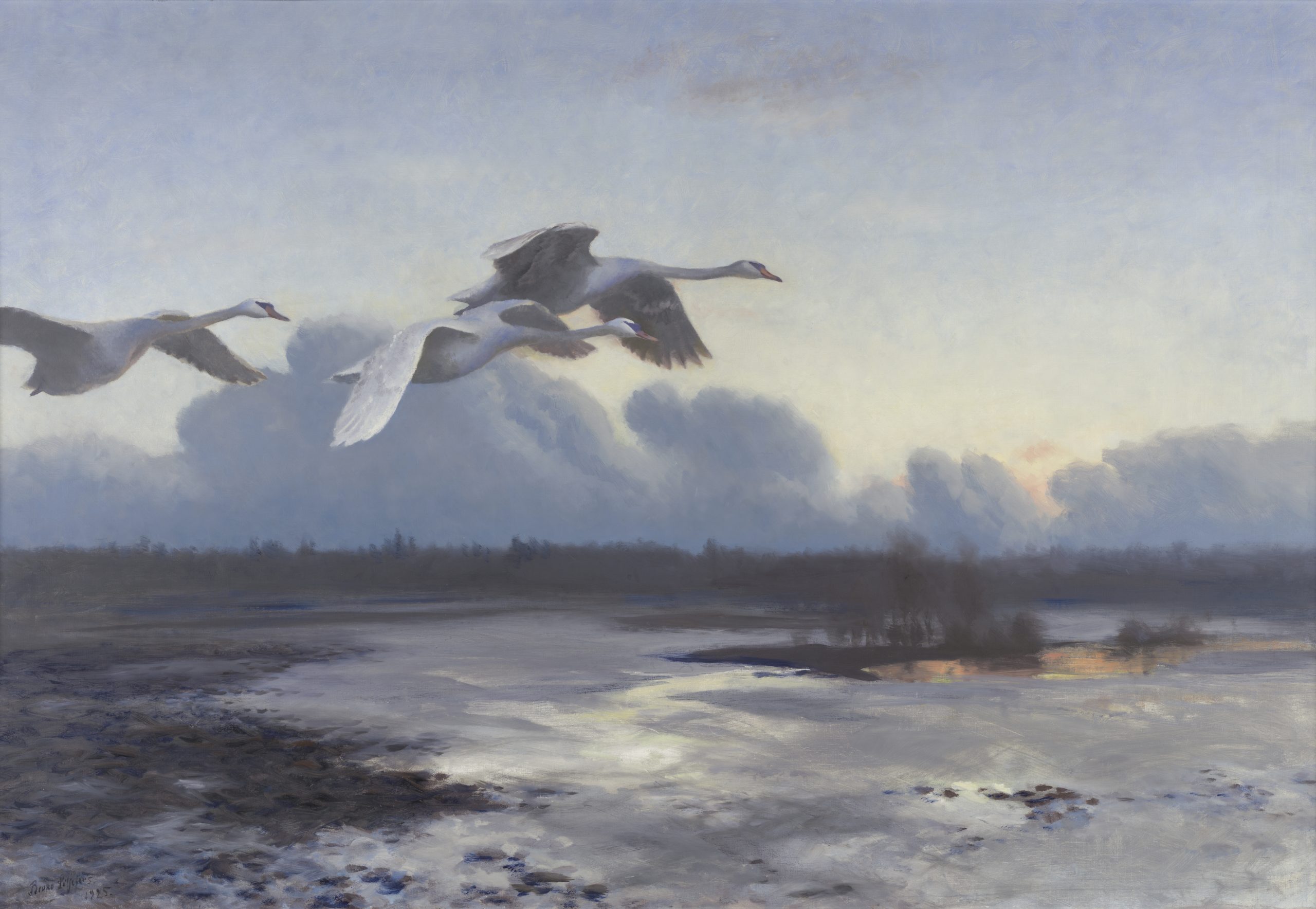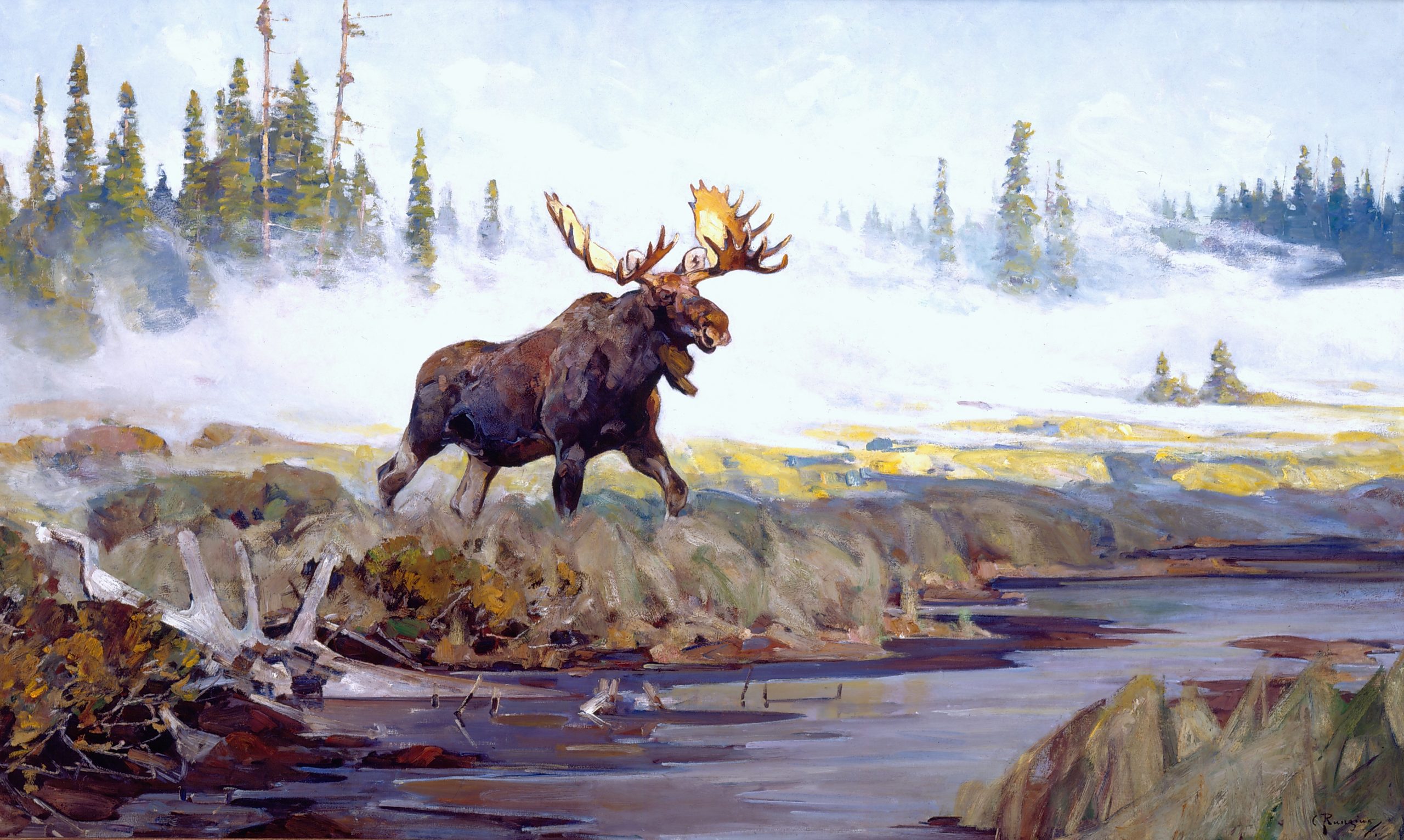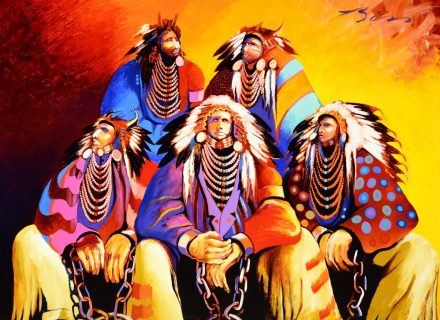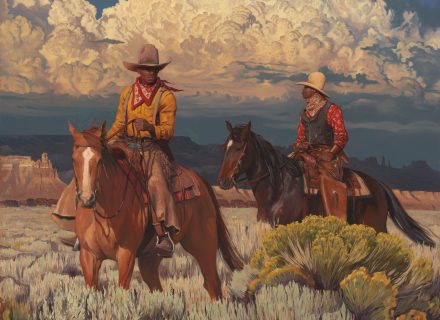Take a wonderful walk on the wild side with the wildlife fine art you didn’t know you needed.
The traveling art exhibition Survival of the Fittest is a collection of masterworks from the Rijksmuseum Twenthe in the Netherlands and the National Museum of Wildlife Art in Jackson Hole, Wyoming, where it opened in May 2023. Now it’s traveling and is at The Briscoe Western Art Museum in San Antonio through September 8 in an innovative installation that’s won special praise.
We talked to show curator Adam Duncan Harris, PhD, Grainger/Kerr director of the Carl Rungius Catalogue Raisonné (an independent project of the National Museum of Wildlife Art); Jason Kirkland, director of exhibitions, collections, and education at the Briscoe Western Art Museum; and Liz Jackson, president and CEO of The Briscoe Western Art Museum in San Antonio about Survival of the Fittest and why it’s worth traveling for.
 Bruno Liljefors (Sweden, 1860 – 1939), Migrating Mute Swans, 1925. Oil on canvas. 41½ x 62 inches. Collection of the Rijksmuseum Twenthe, Enschede, Netherlands. Photograph by Rik Klein Gotink.
Bruno Liljefors (Sweden, 1860 – 1939), Migrating Mute Swans, 1925. Oil on canvas. 41½ x 62 inches. Collection of the Rijksmuseum Twenthe, Enschede, Netherlands. Photograph by Rik Klein Gotink.
Cowboys & Indians: The show Survival of the Fittest envisions wildlife and wilderness through the artists known as the Big Four. Tell us more about those artists and why are they important.
Adam Duncan Harris: The Big Four were an important group of late 19th-century wildlife painters, comprised of American Carl Rungius (born Germany, 1869 – 1959), Germans Richard Friese (1854 – 1918) and Wilhelm Kuhnert (1865 – 1926), and Bruno Liljefors (1860 – 1939) from Sweden.
These artists and their work are worthy of our attention because they were among the first, if not the first, classically trained painters to take their studies out into the field and study wildlife in wild places and do so consistently. Their work advances the animal and its habitat in combination as something that is valuable, worth portraying, and worth protecting in its own right.
Because of the standard they set, future generations of painters and sculptors interested in depicting wildlife could not escape the import of viewing animals in their natural habitats, enacting natural behaviors. And, if you ask almost any living wildlife artist about their influences, at least one member of the Big Four will invariably be mentioned.
C&I: How did these artists envision wildlife and nature? How does that notion influence us today?
Harris: By showing the animal and its habitat as inextricably linked, these artists were sending early messages about conservation. They were demonstrating that healthy wildlife populations needed healthy habitats on which to roam. All these artists were hunters. Hunters formed many of the early conservation groups, like the Bonne and Crockett Club, famously co-founded by conservation champion, Theodore Roosevelt. Sidenote: Roosevelt was also a Rungius collector.
 Bruno Liljefors (Sweden, 1860 - 1939), Pine Marten Attacking Cock Capercaillie, 1923. Oil on canvas. 47¼ x 63¼ inches. Gift of the 2003 Collectors Circle, National Museum of Wildlife Art. National Museum of Wildlife Art.
Bruno Liljefors (Sweden, 1860 - 1939), Pine Marten Attacking Cock Capercaillie, 1923. Oil on canvas. 47¼ x 63¼ inches. Gift of the 2003 Collectors Circle, National Museum of Wildlife Art. National Museum of Wildlife Art.
C&I: How does this show fit in with the Briscoe’s overall mission?
Jason Kirkland: Featuring an exhibition that spotlights wildlife in their native habitats showcases one of the pillars of Western art — the four areas of Western art we work to showcase across our collection, exhibitions, and programs. The term Western art brings to mind cowboys on the range, but the genre is as expansive as the region it depicts, showcasing the rugged beauty of the West alongside the people — and wildlife — who call it home. The subjects of these works and the influence of the Big Four made this exhibition a natural fit for the Briscoe.
Scholars and cultural institutions identify distinct themes within Western art, including wildlife, Native American heritage, and of course, cowboys. Due to the undeniable influence of Mexican and Spanish heritage across Texas and the Southwest, we also celebrate that heritage. Through our permanent collection and traveling exhibitions like Survival of the Fittest, the museum showcases the true diversity of the West, including the Native Americans, vaqueros, cowboys, and pioneering women who rode the range with them.
C&I: This exhibition was curated by you, Adam. Tell us a little about how the show came together.
Harris: The Rijksmuseum in Enschede in the Netherlands and the National Museum of Wildlife Art in Jackson, Wyoming, are the only two museums in the world to hold masterpieces by each of the Big Four.
I first saw the collection in Enschede in in 2003 and have wanted to create an exhibit joining their masterworks and ours at the National Museum of Wildlife Art ever since. A subsequent visit in 2018 with NMWA director Steve Seamons reignited that desire. Curator Paul Knolle at the Rijksmuseum, who had shown me the collection originally and retired by the time we went back, introduced us to the new staff in Enschede and we were off and running.
Our biggest hurdle was negotiating skyrocketing shipping prices, but other than that, everything went surprisingly smoothly. Both the staff at the Rijksmuseum and the staff at NMWA were incredibly helpful and supportive of the project.
 Carl Rungius (Germany, 1869 – 1959), Morning Mist (Harlow Triptych), c. 1930. Oil on canvas. 47 x 79½ inches. JKM Collection®, National Museum of Wildlife Art. © Estate of Carl Rungius.
Carl Rungius (Germany, 1869 – 1959), Morning Mist (Harlow Triptych), c. 1930. Oil on canvas. 47 x 79½ inches. JKM Collection®, National Museum of Wildlife Art. © Estate of Carl Rungius.
C&I: You united these works by the Big Four under the exhibition title Survival of the Fittest. Why does the idea of “survival of the fittest” resonate not just as Darwin’s theory but also as it pertains to wildlife of the West, and, finally, as a metaphor for the West?
Harris: There is a Western ethos that aligns with Survival of the Fittest, that envisions the West as a drama-filled place full of battle or strife. But there is also a way of seeing the West as a place of tranquil beauty, of quiet lives lived (perhaps punctuated with moments of excitement). As we look at the paintings of the Big Four, they definitely painted Survival of the Fittest-themed canvases. However, as they spent more time out in nature, their canvases began to depict the quiet moments in animal lives — a herd of zebras in a field of purple flowers or a group of mountain goats on a rocky cliff. These paintings conveyed a more accurate picture of animals in their habitats and appealed to their patrons, as well.
Kirkland: When you’re viewing the works, they’re timeless — they don’t reflect a certain period, and you don’t have any idea how long it may have taken for them to be completed. Before they literally went into the field — or the mountains, or on safari — the wildlife images you’d see were painted from seeing animals at zoos, with what the artists imagined their habitats to look like. But Darwin’s work changed that. Each of the Big Four immersed themselves in nature to accurately portray the animals and their habitats. It’s easy to overlook the time and effort it took for these artists to do their work, yet they traveled, went on safari for years at a time, and literally lived among the animals. None of that is easy now and it certainly wasn’t easy then. Yet the quality of the works is fantastic and stands the test of time. When you place these works in that context, it is easy to understand why the Big Four were so influential.
C&I: There are 45 masterworks in the show — and displayed along with eight pieces by Robert Kuhn exclusively on view in the exhibition at the Briscoe. Do you have a favorite?
Harris: I am the kind of person who can never decide on a favorite! What I value about each artist is that they focused on different regions of the globe and gave us a sense of native wildlife and habitat particular to those areas. Rungius depicts North American moose, bighorn sheep, and grizzly bears living in the Rocky Mountains. Kuhnert shows us African elephants, lions, and cape buffalo in Tanzania like no one before him had done. Friese unveils lush forests in northeastern Europe housing red deer and European moose. Liljefors demonstrates the active life of sea eagles, eider ducks, and falcons on Sweden’s many archipelagoes. Adding works by Robert Kuhn further highlights their influence — and artists’ continued efforts to capture wildlife in their natural form.
C&I: Let’s talk more about Robert Kuhn.
Kirkland: We initially approached Adam about including Bob Kuhn because his work illustrates the influence of the Big Four, adding a layer that emphasizes their importance. The Briscoe’s installation of the exhibition features eight Kuhn works after you’ve viewed the Big Four, giving visitors a deeper perspective on these four artists and putting their influence into context. It’s easy to see how Kuhn’s work was inspired by theirs — it’s a testament to their lasting influence.
Harris: I’m so happy the Briscoe included work by Bob Kuhn. In many ways, he is the successor to the legacy of the Big Four. Kuhn showed that the next generation of wildlife artists did not need to be bound by geography but could travel across the globe to depict wildlife in wild places wherever it could be found. Like the Big Four, he placed a huge amount of value on field research, but he also placed a huge amount of value on creativity and artistry back in the studio.
 Richard Friese (Germany, 1854 – 1918), Deer in a Forest Glade, 1912. Oil on canvas. 43 x 62½ inches. JKM Collection®, National Museum of Wildlife Art.
Richard Friese (Germany, 1854 – 1918), Deer in a Forest Glade, 1912. Oil on canvas. 43 x 62½ inches. JKM Collection®, National Museum of Wildlife Art.
C&I: The Briscoe Western Art Museum as a venue was singled out recently for special high praise for its particularly innovative installation. One differentiating aspect is the Kuhn pieces. …
Kirkland: With packaged exhibitions, the Briscoe likes to add special touches to make it different from what others may experience at another institution. These works are stunning no matter how you exhibit them, but we work to interpret the exhibition and present it in a way that influences how visitors interact with the works. That’s everything from the color of the walls to the flow of the exhibition — and what we can include to elevate the experience. The Briscoe is one of only six venues across the country that will display this exhibition. It’s truly a once-in-a-lifetime chance to see all these great Big Four artists’ work in one place.
We added four differentiating factors in our presentation of the exhibition: first was the inclusion of the Kuhn works; second the addition of taxidermy mounts; and third was a video with an interview of Adam by the local PBS affiliate in Wyoming, adding some context for visitors to deepen their understanding of the Big Four; and fourth, an educational drawing studio for adults and kids alike to sketch wildlife and landscapes in the gallery.
And of course, the Briscoe is lucky to have a Rungius in our permanent collection, Rainbow Rams, c. 1945, oil on canvas, 16¼ x 20¼ in., gift of the Jack and Valerie Guenther Foundation. Rather than include it in the exhibition gallery, it’s on display in the museum’s permanent collection, giving visitors context for how Rungius fits into Western art as a whole. With that Rungius and the Kuhn works, there are 54 wildlife works for visitors to enjoy through September 8.
C&I: Any parting thoughts about the exhibition?
Liz Jackson, Briscoe president and CEO: These four artists traveled and observed wildlife in their natural environment, studying each species to better capture not only the details, but the essence of these animals. Today, we can tune into nature documentaries and see stunning photographs of these animals, but these artists didn’t have that ability — and neither did the public. Their work captured these animals, sharing a realistic portrayal that stands the test of time, showcasing the impact of Darwin’s work. The works are stunning and a must-see for anyone who appreciates the beauty of nature and the West as a whole.
Survival of the Fittest is on view through September 8 at the Briscoe Western Art Museum in San Antonio. For more information, visit briscoemuseum.org.

















